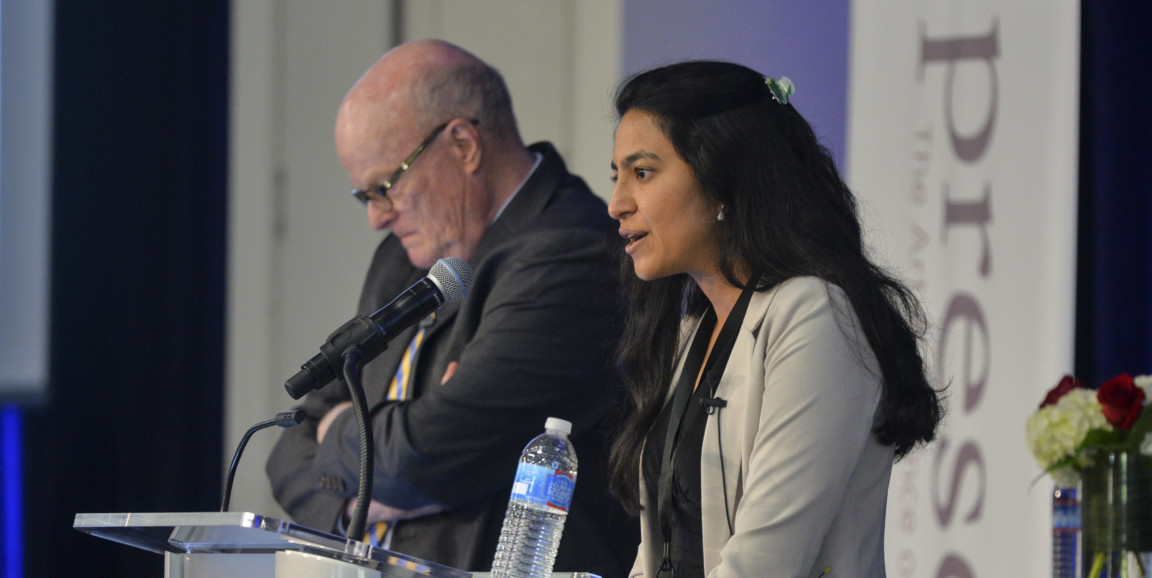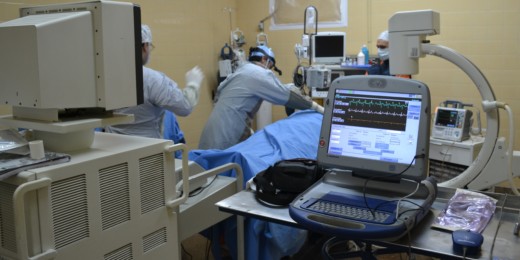The moment arrived before she expected it, but Tanya Gupta, MD, was prepared.
For more than 40 minutes, in front of a symposium audience, the Stanford chief resident in medicine had carefully presented clues about a theoretical patient's illness. It was the job of master diagnostician Lawrence Tierney, MD, to provide the answer, to name the disease.
Now, like magician Harry Houdini performing a public escape, Tierney, a professor of medicine at the University of California, San Francisco, began the build up to his pronouncement.
A list of nine possible diagnoses hovered on two large screens beside Tierney and Gupta. She arranged her features into a neutral expression, determined to give nothing away.
The demonstration, part of the Presence Center's Human Intelligence and Artificial Intelligence in Medicine Symposium, aimed to show in real time how an expert physician puzzles through a mystery diagnosis. Tierney took on the role of medical detective and Gupta guided him through the case of a real patient with some details changed.
Tierney, and the audience, learned at the onset that a 35-year-old woman arrived at the hospital seven days after delivering a baby, with severe and worsening pain in the upper left part of her abdomen. The patient suspected a fever, but hadn't checked her temperature.
Tierney took it from there. Pondering the location of the pain, Tierney zeroed in on a possible problem with the spleen, which could be felt in the shoulder.
Gupta nodded. "It turns out she has been having some left shoulder ache for the last seven days, as well," she said. "She hadn't thought much of it until you brought it up."
Tierney had additional questions: Does she have a chronic illness that would affect her colon? Has she had kidney issues? Was there any problems with the delivery?
No chronic illness, Gupta responded. No kidney issues, no problems with the delivery.
The questions and answers continued. Tierney learned that the patient had not had a blood transfusion, and didn't smoke or use drugs or alcohol.
He turned to the audience. "Right now, I think most clinicians like moi would be thinking, well, what kind of disease is this? And there are only a small number of generic types of illness." He listed them: infection, tumor, metabolic, traumatic, degenerative, congenital. He added autoimmune, then paused. There is an autoimmune disorder that can cause a loss of blood supply and lead to clots in organs, such as the spleen, he noted.
"Hmm," Gupta said.
The next clues revealed that the patient had her gallbladder removed about two years ago; and during her pregnancy, she experienced two blood clots, one in each leg.
"Well, you could say that this patient has -- ding! -- paroxysmal nocturnal hemoglobinuria," Tierney said. He explained that it's a disease characterized by the destruction of red blood cells and blood clots, including in the spleen.
"Hmm," Gupta said.
Tierney backtracked. "I get the sense it probably isn't because the presenter, doing her job, went 'Hmm, that's interesting'," he said to loud laughter from the audience.
Gupta, smiling, sidestepped the comment and unfurled more information. In the past, the patient had tested positive for factor V Leiden, a heritable disorder for the propensity to form blood clots. Neither her physical exam nor her lab tests revealed anything of note.
"At this stage," she said, "where would you go next in her case?"
"Any radiologist around?" Tierney asked.
A CT scan of the patient's abdomen revealed not a blood clot in the spleen, Gupta said, but a small localized area of dead tissue resulting from a failure of blood supply.
It could still be a disorder involving blood clots in arteries and veins, Tierney said. They talked through the possibilities, and Gupta posted the list of nine diagnoses. Tierney, arms folded, smile on his face, started ticking them off.
No to the first diagnosis. Yes to the second. The third? Probably not. The fourth, fifth, sixth, seventh, eighth, all crossed off. He paused at the ninth, patent foramen ovale (PFO).
"That means a little hole in the heart that could lead to a clot from the leg going through that hole into the systemic circulation and embolizing to the spleen," Tierney said, clearly enjoying the case's unusual twist.
Gupta listened. She touched her lip to her finger. She nodded vigorously.
"I like PFO," Tierney said, after offering one other diagnosis. "I really do."
"Perfect," Gupta said. She changed the slide to show an echocardiogram, an interior image of a heart beating.
Indeed, there was a hole.
Photo by Rod Searcey






